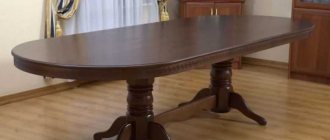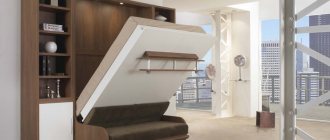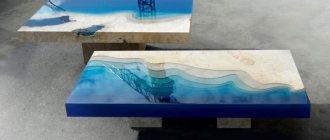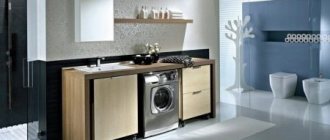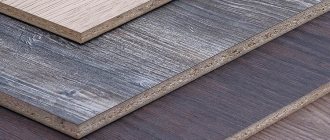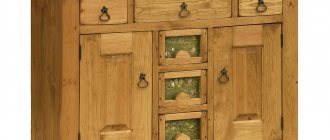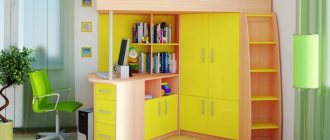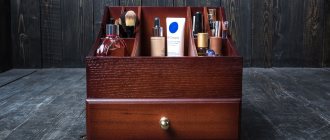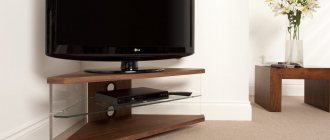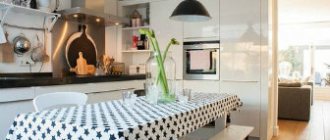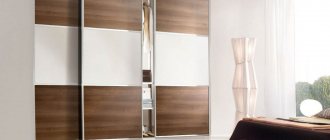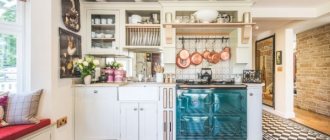The kitchen is the most important room in an apartment or cottage. After all, a person needs to eat, get strength for the next day. A large part of life takes place in the kitchen space. Therefore, it must be decorated properly. Modern design trends have reached a new level. Nowadays, postformed countertops have come into fashion. Behind the unusual name lies a well-known product. But how are such products made? What's remarkable about them? What options are there for finishing them? Let's figure it out.
Today, countertops with postforming have become fashionable. Behind the unusual name lies a well-known product.
What types of countertops are there?
Furniture in the kitchen should not only be beautiful, but also comfortable, functional and practical. The countertop is one of the integral components of the kitchen environment. It is important that it is also of high quality and durable, because it is on it that most manipulations are performed.
Let's look at what types of countertops there are. The canvas for covering kitchen cabinets is made from various materials, for example, such as:
- natural and artificial stone;
- tree;
- chipboard (chipboard);
- medium density fiberboard (MDF);
- metal;
- concrete.
What material to choose for the countertop is purely a matter of taste
The choice of material for the countertop directly depends on your taste and financial capabilities, since products made from stone and wood are:
- the most practical;
- durable;
- durable;
- but also the most expensive.
Products made from MDF are in the mid-price range. The most budget option, but also the most common and popular, would be a countertop made of chipboard.
It is very important for the countertop that it is moisture resistant and resistant to damage. Therefore, when purchasing an inexpensive chipboard product, it will be useful to learn about postforming technology.
The countertops must be moisture resistant and highly resistant to damage.
Postforming countertops
This finishing method is also very popular in the kitchen. A significant part of kitchen furniture is produced using the postforming method. Every housewife knows what it means to have a reliable, durable countertop. This is the workplace that is most often exposed to pressure, cuts, moisture, etc.
The surface coated with a layer of protective resins has a high strength index. Swelling of the slab and its deformation are excluded, since moisture does not penetrate inside. The surface of the postforming tabletop is protected from high temperatures, cleaning chemicals and mechanical influences.
What is postforming
The concept of postforming is quite broad. In addition to the fact that this is the name of the technology itself, it can also include any chipboard and MDF products made using this method.
Postforming technology is a method of covering products made of chipboard or MDF with a laminated film, which is plastic consisting of several layers. Using this technology, plastic is heated to a temperature of 220 degrees and the base of the future product is covered under high pressure. The coating on the slab has no seams, which means that the product is less vulnerable to external factors.
Paper impregnated with special resins turns into plastic that reliably covers the tabletop
The laminated film, which covers the surface of the product, as already mentioned, consists of three layers:
- durable base consisting of several layers of kraft paper, which is impregnated with synthetic resins;
- a layer of paper with a pattern that performs a decorative function;
- a layer that protects the tabletop from moisture and damage, consisting of paper impregnated with acrylic and melamine resins.
Decorative coating using this technology can be designed in any style, color scheme and absolutely any ornament. Everything that the customer’s imagination is capable of can be accomplished in production. In construction hypermarkets you will find laminated countertops in standard colors, most often they are plain or imitate marble, wood, or granite.
The last layer of the tabletop is protective
The last, protective layer, protects the surface from various mechanical, chemical damage and moisture on the chipboard base. The layer, for example, will withstand accidental contact with a fork or knife, will tolerate non-aggressive cleaning agents, spilled tea, coffee and juices will also not cause harm. But still, you should not experiment, and you need to take care of the product in a timely manner, especially if you spill substances such as hydrogen peroxide, coloring compounds, and glue. Despite the fairly good wear resistance, it is still not recommended to cut with a knife directly on the countertop. After all, any surface, if treated carelessly, will sooner or later lose its quality and appearance.
The tabletop needs a drip tray so that it drains moisture from its surface more efficiently.
Postforming also has an “Achilles heel”, namely the side opposite the laminated one. It is covered with simple kraft paper, which in no way protects the product from moisture or damage, so any liquid spilled on the surface should be wiped up immediately to avoid getting on the back of the tabletop.
How to properly care?
Proper surface care is not difficult. It is enough to do the cleaning on time and use cleaning products if necessary. For example, to prevent gray spots from appearing on a light panel, greasy stains are immediately covered and washed with soda. When removing dried stains, use a soft cloth or sponge with warm, soapy water. Use an iron brush as a last resort, especially if the surface is smooth, because it will leave microscopic scratches that will eventually destroy the gloss.
Even if you choose premium postforming, you need to wipe the table dry after cooking and periodically polish the surface. Wiping is necessary in order to avoid the formation of limescale. It is also important to ventilate the room, because with high humidity, mold can form on the surfaces, which will damage the material.
- Which dining table to choose for the kitchen?
Kitchen set for your kitchen
How to choose a bathroom for the kitchen?
You need to be careful with the surface. If you place dishes at more than 220 degrees, dents, bulges and color changes may occur. Such a panel cannot be restored; it will require a complete replacement. You can take convenient coasters for hot food and the table will be unharmed.
Mechanical impacts also cannot be restored on the panel. Severe cuts or chips not only affect the appearance, but can also cause swelling if moisture gets in there. Therefore, it is better to always use a cutting board.
The table may be affected by caustic substances that emit fumes. Therefore, it is better to store them in another closed place. Weak natural acids contained in vegetables, fruits, and juices can also affect the loss of color and surface smoothness.
The detergent must be non-abrasive and not contain aggressive compounds (chlorine). Contact with leave-in technical products (acetone, bleach, ammonia, etc.) and household products (hair dye, manganese, brilliant green, etc.) should be avoided, and if contact occurs, immediately eliminated. They can lead to irreparable consequences.
Types of countertop cladding
There can be two types of cladding for the base of the tabletop:
- 90 degrees;
- 180 degrees.
Postforming 90 degrees involves facing the product only on two sides, which are located at right angles to each other - this is the surface itself and the front end. This method has a significant drawback - the absence of a drip tray. That is, if water gets on the countertop, then pouring down, it will wet the lower surface of the product, which is extremely undesirable, because, as you know, chipboard is a material that is afraid of moisture. Therefore, it is necessary to treat the bottom joint of such a countertop with a silicone-based sealant.
Drip tray on the countertop
Postforming 180 degrees implies that the surface of the tabletop, the end and a short distance of the bottom side are lined with plastic in a U-shape. This creates the opportunity for spilled drops to collect and flow onto the floor without falling on the unprotected base of the product.
Where to buy a postforming countertop in Minsk and Grodno?
In 2021, there are a lot of facing materials for kitchen units, but the most popular is the post-forming countertop for the kitchen. In terms of quality characteristics, it is no worse than natural or artificial stone.
At the Ramax company in Minsk and Grodno, you can always buy a postformed kitchen countertop from the Austrian manufacturer Egger. Egger cares about human health and nature, so the elements included in its composition are completely safe for everyone.
“When choosing Egger, rest assured that the work surface will last a long time.”
The company guarantees:
- Quality;
- Affordable price;
- More than 200 colors;
- Practicality and beautiful appearance;
- Safety;
- Durability.
Buy a post-forming countertop for the kitchen at a competitive price from Ramax. We offer a lot of profitable options that will definitely suit your headset. See Egger countertops catalogue . Each position is full of quality characteristics and corresponding cost. Good choice! We are sure you will find what you need.
What sizes are there?
It is worth knowing that manufacturers have the opportunity to produce tabletops of different, non-standard sizes, it depends on the wishes of the customer. The maximum length can reach 4 m. But basically, in stores you will find two standard sizing options:
- length – 305 cm, width – 62 cm;
- length – 224 cm, width – 60 cm.
The thickness of the tabletops can be 28 and 38 mm.
In this case, all countertops will be covered with laminated film on only two sides - the working surface and the front end. The side and rear edges remain unprocessed. This is done so that during the installation of the product the master can file it, if necessary, or add it using a connecting strip. In any case, upon completion of the installation of the tabletop, its edges are covered with edge strips.
What are the options for countertops?
How to choose and care for a countertop?
First, let's deal with the issue of choosing a product. What you should pay attention to when purchasing or ordering is:
- product quality;
- customer reviews;
- the number of customers in a store or at a specific supplier;
- storage conditions in the warehouse (if possible to view).
When choosing a kitchen countertop, read customer reviews about product quality
Before ordering a countertop, you need to measure the dimensions of the kitchen, or better yet, call a furniture team to your home so that they can take measurements of the room themselves.
Before ordering a countertop, you need to measure the dimensions of the kitchen, or better yet, call a furniture team to your home so that they can take measurements of the room themselves.
Be sure to learn about the method of processing seams (if any) as well as sealing edges. In some cases, they can be lined with metal strips, in other cases they can be covered with the same plastic using the hot gluing method. The second method is of better quality.
Before purchasing a countertop, find out how the seams were processed
A countertop with postforming does not require special care. There is no need to clean the surface with abrasives. Give preference to liquid cleaning products. All joints must be treated with sealant to prevent water ingress. But you should immediately remove excess moisture that gets into such a place, even if there is an abundance of sealant there.
Give preference to gentle cleaning products, so you will maintain the beautiful appearance of the countertop for a long time
See also Types of electric stoves for the kitchen.
Advantages and disadvantages of postforming countertops
Like any product made using postforming technology, countertops have their own advantages and disadvantages. Using the table as an example, we will consider the positive and negative aspects of the most common type of kitchen surface, made of particle board.
Table 1. Advantages and disadvantages.
| Advantages | Flaws |
| 1. Affordable price due to low-cost manufacturing technology and inexpensive materials used. 2. Huge palette of colors. The ability to choose any color and print is achieved due to the fact that absolutely any design can be applied to the decorative layer. 3. Sufficiently high wear resistance of the surface is achieved precisely thanks to postforming technology. 4. Over time, the surface pattern does not wear off or fade. 5. Not afraid of elevated temperatures. This does not mean that you can place hot dishes from the stove on the surface, but postforming will easily withstand proximity to the hob. 6. The countertop is easy to care for; it can be easily washed using any dishwashing detergent. | 1. Postforming countertops are manufactured only straight. If you need a U-shaped or corner one, you will have to join several tabletops, cut to the dimensions you need. 2. The service life of the countertop depends on the quality of the plastic used; the worse the plastic, the sooner you will find it peeling, bubbles or other defects. 3. Impossibility of repairing the product. If somehow mechanical damage occurs, then the entire tabletop will have to be replaced, since it cannot be repaired. 4. Contains formaldehyde resins, which can initially emit an unpleasant odor and are quite harmful to humans. 5. The service life of the product is on average five years. |
An MDF tabletop will have different parameters than a chipboard tabletop
A postforming tabletop based on MDF will have slightly different indicators, since the board itself has a different density than chipboard. MDF, unlike particle board, has no voids; it is a very tightly compressed material that does not contain formaldehyde and other resins, which means that it is environmentally friendly and safe for humans. In addition, due to its texture, the wood fiber material can be given smooth rounded shapes - the board will not crumble, as is the case with chipboard.
MDF board is laminated according to the same principle as chipboard, and their main indicators are the same, except that MDF is more resistant to moisture and mechanical damage. But the price of fiberboard is higher than that of particleboard.
MDF is much more resistant to moisture than chipboard
Advantages and disadvantages
The developed postforming manufacturing technology makes this method the most attractive for builders and designers, since it has a number of significant advantages:
- Due to the high resistance to abrasion and detergents that plastic has, postforming can last a very long time.
- The color palette offers up to 200 different shades, which allows you to bring any design solution to life.
- The selected plastic can also be used to create other interior parts in the form of shelves, canopies, etc.
- For postforming, environmentally friendly plastic is used, which is the safest for human health.
- The water resistance of this finish allows it to be used in any room.
- Postforming facades can have a variety of sizes and can also be bent, straight or curved.
- Low cost.
The only downside worth noting is that if the surface is damaged, it is almost impossible to restore it.
Tools and components required for countertop installation
So, the countertop has been purchased, and if you have not used the services of professional installers, you will have to install it yourself. Let's take a step-by-step look at all the questions and steps related to installing a postforming countertop.
Before starting work, prepare the tools and components that you will need in the process:
- table top canvas;
- roulette;
- pencil;
- level;
- jigsaw;
- drill;
- silicone sealant;
- metal strips;
- wall plinth;
- edge tape.
Convenient to use jigsaw
Postforming installation instructions
Step No. 1 - take the necessary measurements
Measure the required length of the product taking into account the width of the end strip. Use a jigsaw to saw off the extra centimeters. Treat the ends with sealant and use small self-tapping screws to attach an end strip that will protect the tabletop from moisture. Wipe off any remaining sealant from the surface using a cloth moistened with acetone. Don’t forget to also treat the back end of the tabletop with silicone and preferably the edges of the cabinets on which our tabletop will lie.
We make the measurements we need
Step No. 2 - make the necessary cuts
Mark the locations for the required openings, for example for a hob or sink. To make the cuts neat, outline the location of the future cut with a pencil, drill holes along the drawn line with a drill, and use a jigsaw to cut out the space for the sink or stove. Treat the edges with silicone compound. Try on the sink and hob. It will be easier to immediately adjust the holes at this stage than at the final stage.
Cutting out an opening for a sink
Silicone treatment
Make a fitting of the sink or hob at this stage
Step No. 3 - installing the countertop
Now we install the tabletop itself. We lay it on the lower cabinets of the kitchen unit. We check the level, if necessary, we tighten the legs of the cabinets, but if this is not possible, place special plastic pads or wedges under the legs for adjustment. The tabletop needs to be secured to the cabinets with self-tapping screws. If the kitchen set is new, then it has special strips with holes for self-tapping screws through which you can fasten the countertop. If there are no such strips, use metal or plastic corners, especially for the cabinet under the sink. You will need self-tapping screws with a length of 30 mm and 16 mm.
If the geometry of your kitchen requires an L-shaped countertop, then the panels are connected to each other using a joining strip.
Putting the tabletop in place
The sink is a functional element in the kitchen that is used every day, so its installation should be given special attention to avoid further problems with leaks. In addition, the attachment of the sink to the countertop (from below or from above) must be reliable so that it does not fall down along with the dishes or water. In a special article, we will look at detailed methods for installing various types of sinks on the countertop.
Step No. 4 - install the wall plinth
All that remains is to install the wall plinth between the kitchen apron and the countertop. The plinth can be secured with self-tapping screws or glued. But in both cases, treat the joints with silicone sealant to prevent moisture from getting into them. You can often find single-color skirting boards. They are not color coordinated with most countertops, but are made so that the buyer can match the edge strip to the color of the countertop and insert it into the baseboard.
After installing the set along the line where the table top meets the wall, you need to secure the baseboard
Such products are sold in the form of structures consisting of two parts - the inner part and the strip. You will learn more about how to attach a baseboard to a kitchen countertop in our article.
Qualities that make postforming popular
The main advantages of postforming boards are water resistance, mechanical strength, resistance to ultraviolet radiation and aggressive environments, and heat resistance. Postforming products have the following structure:
- MDF or chipboard;
- melamine edge;
- kraft paper;
- decorative plastic;
- durable protective layer.
To produce high-quality household and office furniture, postforming with rounded edges (on both sides) is used. Although postforming is much more expensive than laminated chipboard, it is a very popular material that has received well-deserved high ratings from consumers in many countries.
Tips for choosing, installing and caring for surfaces
- The most convenient option would be a solid tabletop, without joints. In this case, it will have a more expensive appearance and it will be more convenient to work with such a product.
- The countertop should be in harmony with the design of the kitchen unit and the color scheme of your kitchen as a whole. Thanks to a wide selection of postforming color options, you have the opportunity to choose a countertop in the same style as your kitchen design. So, for example, if you have a country-style kitchen, then a wood pattern will come in handy. A high-tech kitchen will suit a plain gray-silver surface. For classics, manufacturers present a wide selection of light colors that imitate marble and granite.
- The countertop surface should be level with appliances and other cabinets. This is especially important if you are not installing the entire surface, but are building on an existing one.
Ergonomics in the kitchen
- If you need to saw off a product, try gluing masking tape at the level of the intended cut - it will help prevent chips and cracks.
- If, nevertheless, small chips appear, sand them with a file or sandpaper and treat them with silicone.
- It is preferable to choose a worktop with a thickness of 38 mm for the kitchen, as it fits perfectly under the built-in hob, and is also more reliable and durable. And many manufacturers of ready-made kitchens produce countertops of just this thickness with moisture-resistant impregnation.
Moisture-resistant and regular countertops have different interior materials
- In order for the countertop to last as long as possible, promptly remove all spilled liquids from it; laminate flooring especially does not “like” vinegar.
- When cutting food on the countertop, use cutting boards. Here you need to understand that scratches on the surface are not just a spoiled appearance. Moisture seeping through the scratches into the body of the tabletop will cause it to begin to swell and swell from the inside. And you will have to change the product.
Stylish examples
Thanks to the unique texture of facing plastic, kitchen countertops have any patterns and structures. It is very easy to produce an imitation of natural wood, stone, ceramic tiles and even natural glass. In addition, on such a surface, in modern production, patterns are printed, landscapes and photographs are applied.
Stylish marbled kitchen countertop
Tables finished in a glossy format look especially beautiful. For classic styles such as Provence, English and Scandinavian, as well as for modern High-Tech and Minimalism, gloss is very suitable. Let's look at an example of the French Provence style, mixed with a Scandinavian motif.
Kitchen in Provence style with postforming countertop
Finishing begins with the floor covering. Planed parquet boards treated with clear varnish will look good. The latter must be applied in several layers to protect the wood from dirt and moisture. Birch or ash will do. Here it is important to make the floor tone white.
The color of the countertop and floor is almost identical, which makes a wonderful ensemble in the kitchen
The kitchen set is purchased to match the color of the floor covering. Find a quality product with standard paneled cabinets. Ordinary straight doors will also work, but they won’t look as nice. The tabletop is selected with a marble texture. Choose another dominant interior color. Since there is already one - white. It is set by the “Provence” style. The second color, for example, is green. Then the plastic covering of the desktop headset will be white and green, with a marble texture. Make the backsplash piece the same structure as the desktop.
Kitchen with postformed marble countertop in Provence style
Buy hanging shelves the same as floor cabinets. Whitewash the walls with simple whitewash or paint them with white paint. Place vases with green plants around the perimeter of the kitchen table. Since we have a dual style - Provence, combined with a Scandinavian motif, white and green colors will be the best choice, fully characterizing both of these directions. But you can add a little beige, warm tint to white.
Postforming countertop in a kitchen in Provence style, combined with Scandinavian style
Try to combine several interior design styles. This way you will get an unusual, unique design, not like the others. And postforming countertops will fit perfectly into your fantasies.
The postforming countertop will look great in any kitchen
See alsoWallpaper Erisman catalog - choice of wallpaper for the home
How else can you use postforming countertops?
The kitchen set is not the only place where you can use a countertop made using postforming technology. For example, you can use post-forming to decorate a trendy island or bar counter in modern kitchens.
Due to the fact that today the countertop can be purchased separately from the entire set, and construction hypermarkets offer us a huge selection of all kinds of accessories and spare parts for furniture, you can design a very convenient element in your kitchen - an island.
Countertops for the island must be arranged in accordance with the same requirements
The basic requirements for the surface under the island are exactly the same as for all countertops. The only difference is that when installing the surface on a kitchen cabinet, no one will see the back, untreated end. And for the island it is important that all ends are lined with edges. And this is where edge tape comes to the rescue.
All you need to do is choose the product according to the color and thickness of the tabletop. It will not be difficult to glue the edge, since hot-melt adhesive is applied to its reverse side. All you have to do is heat up an ordinary household iron to medium temperature, warm up the edge and, using smoothing movements, glue it to the end. Under the influence of temperature, the glue will melt and, subsequently cooling, will reliably and firmly connect the edge to the edge of the tabletop.
Furniture edging: types
If it happens that the edging tape has come out beyond the edges of the end, or you did not calculate the size and took it a little wider than necessary, then carefully remove the excess using a file. To sand the resulting joint, use a laminate wax chalk. Apply it several times along the joints and rub it in with a gloved hand or a cloth.
Thus, your countertop will be edged around the perimeter and can be installed in the middle of the kitchen - it will look aesthetically pleasing from any side.
Postforming tabletops can also be used to create small kitchen or even children's tables. Having sawed off to the required size, edge the edges and secure them to the legs, which are also sold in a large selection at any construction hypermarket.
The method of making countertops that interests us is also relevant for other types of furniture.
Criterias of choice
According to reviews, countertops treated with such a film last 10–12 years longer than conventional materials. When purchasing a product, they look at several points at once:
- Quality. You should not rely only on the words of a consultant; it is better to check the quality certificate yourself and make sure that the postforming countertop meets the specified parameters.
- Defects. In case of careless delivery, cracks and chips form, which subsequently affect the service life, so it is better to refuse such products.
- Emission class. This indicator indicates the environmental friendliness of the material used. Safe postform kitchen countertops are free of toxins. They have emission class E1 or E0.
- Type of plastic for cladding. For this purpose, HPL or CPL is used. The first option is thicker and more resistant to wear, so it is worth choosing it.
- Moisture resistance. Since the kitchen has special operating conditions, it is better to choose material for the base that is resistant to moisture. This characteristic is checked on the raw edge. Moisture-resistant raw materials have a blue or green tint. Manufacturers specifically add pigment so that buyers can distinguish one material from another.
